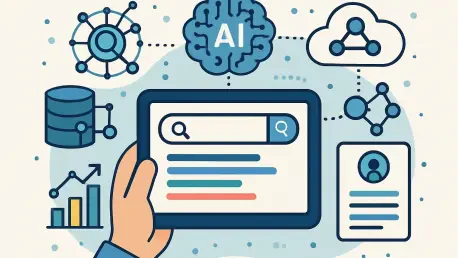I’m thrilled to sit down with Chloe Maraina, a trailblazer in the realm of business intelligence and data science. With a passion for weaving compelling visual stories from big data, Chloe has become a visionary in data management and integration. Today, we’ll dive into the transformative world of semantic search and AI, exploring how these technologies are revolutionizing data discovery, empowering businesses, and accelerating innovation. Our conversation will touch on the power of semantic layers, the democratization of data, and the profound impact on AI and analytics, shedding light on how organizations can move from days of searching to seconds of answers.
Can you break down what semantic search is and how it stands apart from the traditional keyword-based approach?
Absolutely. Semantic search is all about understanding the meaning and intent behind a query, rather than just matching words. Traditional keyword search is rigid—if you don’t know the exact terms or column names, you’re often stuck with irrelevant results or nothing at all. Semantic search, on the other hand, interprets what you’re really asking. For instance, if you type “revenue by region Q2,” it figures out that “revenue” is a business metric, “region” is a category, and “Q2” is a time filter. It’s like having a conversation with your data, and it’s a game-changer because it focuses on what you mean, not just what you say.
What exactly is a semantic layer, and how does it tie into the idea of semantic search?
A semantic layer is essentially a bridge between raw, complex data and the people or systems using it. It’s a shared, business-friendly model of data that defines metrics, hierarchies, and relationships in a consistent way. Think of it as a universal translator—it takes the messy, technical underpinnings of databases and turns them into terms business users understand. When paired with semantic search, it allows users to ask questions in natural language and get accurate, governed answers without needing to know the backend structure. It’s the foundation that makes semantic search so powerful.
How does semantic search transform the way organizations manage data compared to older methods?
Semantic search flips the script on data management. Older methods, like traditional business intelligence systems, often relied on rigid setups—think data marts and lengthy ETL processes that duplicated data into silos. This meant delays, inconsistencies, and heavy reliance on IT. Semantic search, supported by a semantic layer, cuts through that by providing live, governed access to data from a single source. It tackles challenges like slow response times and fragmented definitions, enabling organizations to be more agile and aligned in how they use data.
In what ways does semantic search speed up the journey from asking a question to getting an answer?
It’s night and day. With semantic search, you’re not wading through irrelevant results or waiting days for IT to build a dataset. It understands your intent and delivers precise answers in seconds. Imagine a retail manager needing sales insights for a urgent promotion decision—semantic search can pull that data instantly, whereas older systems might take days. It cuts out the middleman, reducing dependency on data teams and letting business users act fast when it matters most.
How does semantic search make data more approachable for people who aren’t tech-savvy?
It lowers the barrier to entry in a big way. Non-technical users don’t need to learn SQL or understand database structures—they can just ask questions in plain language, like “What were sales last quarter by region?” The semantic layer translates that into the right query behind the scenes. This means marketers, managers, anyone really, can explore data without a steep learning curve. It streamlines daily operations by empowering more people to make data-driven decisions without bottlenecks.
Why is it so critical to have consistent data definitions across an organization, and how does a semantic layer help with that?
Consistency is everything. When different departments define metrics like “customer churn” or “net revenue” in their own way, you get chaos—disagreements over numbers, mistrust in reports, and bad decisions. A semantic layer solves this by creating a single, governed set of definitions that everyone uses, whether they’re in finance or marketing. It builds trust because everyone’s working from the same truth, and that alignment is crucial for collaboration and confidence in the data.
Can you explain what data democratization means in the context of semantic search?
Data democratization is about giving everyone in an organization access to data in a way that’s safe, governed, and easy to use. With semantic search and a semantic layer, you’re not handing out fragmented spreadsheets or data exports that can lead to errors or security risks. Instead, you provide a unified interface where people can explore data on their own terms, without duplicating it or breaking governance. It’s a shift from restricted, siloed access to a shared, trusted ecosystem, and it’s vital for fostering a data-driven culture.
How does semantic search play a role in enhancing AI and analytics, especially in building models?
It’s a huge accelerator for AI. Data scientists often spend most of their time wrangling data—finding it, cleaning it, aligning it from different sources. A semantic layer, paired with semantic search, streamlines that by providing unified, consistent data with built-in business logic. This means they can start training models sooner and experiment faster. It also ensures the data feeding into AI, like large language models, is context-rich and reliable, which cuts down on errors and boosts the quality of outputs.
What’s your forecast for the future of semantic search and AI in shaping how organizations interact with data?
I see semantic search and AI becoming the backbone of how organizations access and leverage data. Just as web search transformed how we find information online, semantic layers and AI-driven discovery will redefine enterprise data interaction. We’re moving toward a world where data discovery is instantaneous and intuitive for everyone, not just specialists. As AI continues to grow, semantic search will be the connective tissue between human questions and machine intelligence, driving not just speed but also trust and innovation. Organizations that adopt this now will have a massive edge in agility and decision-making.









